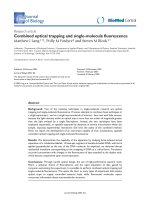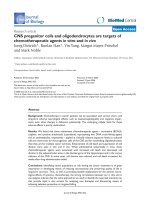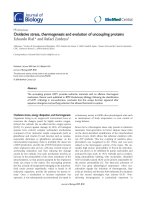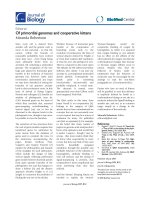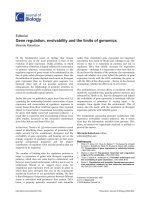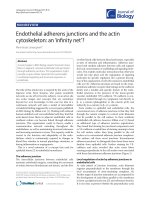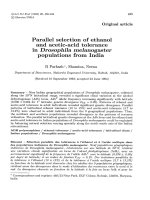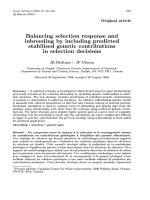Báo cáo sinh học: "Approximating selection differentials and variances for correlated selection indices" pptx
Bạn đang xem bản rút gọn của tài liệu. Xem và tải ngay bản đầy đủ của tài liệu tại đây (740.99 KB, 15 trang )
Original
article
Approximating
selection
differentials
and
variances
for
correlated
selection
indices
F
Phocas
JJ
Colleau
Institut
national
de
la
recherche
agronomique,
station
de
génétique
quantitative
et
appliquée,
78352
Jouy-en-Josas
cedex,
France
(Received
1st
June
1994;
accepted
1st
August
1995)
Summary -
Empirical
formulae
were
derived
to
approximate
selection
differentials
and
variances
of
the
selected
estimated
breeding
values
when
the
estimated
breeding
values
of
the
candidates
for
directional
selection
are
multinormally
distributed
and
correlated
in
any
manner.
These
formulae
extended
the
well-known
exact
basic
form
for
the
equicorrelated
case,
taking
into
account
selection
pressure,
average
pairwise
correlation
coefficient
and
average
standard
deviation
of
pairwise
correlation
per
observation,
through
polynomials
fitted
to
simulated
data.
Simulations
were
carried
out
for
different
correlation
structures
(1,
2
or
3
different
intra-class
correlations
per
family,
ranging
from
0.3
to
0.99),
for
different
numbers
of
independent
families
(1,
2,
5
or
10),
for
constant
or
variable
family
size
and
for
selection
pressures
ranging
from
0.5
to
50%.
On
average,
90%
of
the
bias
occurring
when
ignoring
correlations
between
observations
was
removed
by
our
prediction
formula
of
selection
differential
or
variance
of
selected
observations.
Comparisons
with
other
correction
methods,
which
assume
special
correlation
structures,
were
also
carried
out.
selection
differential
/
correlated
indices
/
finite
population
Résumé -
Approximations
empiriques
des
différentielles
de
sélection
et
des
variances
pour
des
indices
de
sélection
corrélés.
On
propose
des
formules
de
calcul
approché
des
différentielles
de
sélection
et
des
variances
d’index
de
sélection
après
sélection
direction-
nelle
quand
les
candidats à
la
sélection
ont
des
index
distribués
normalement
et
corrélés
de
manière
quelconque.
Ces formules
ont
pour
base
celles
établies
en
cas
d’équicorrélation
en-
tre
observations
et
font
intervenir
des
polynômes
des
variables
suivantes :
taux
de
sélection,
coefficient
de
corrélation
moyen
et
écart
type
moyen
de
ce
coefficient
par
observation.
Les
coefficients
des
polynômes
sont
calculés
après
ajustement
à
des
données
simulées.
Les
situations
simulées
font
varier
la
structure
des
corrélations
(1,
2 ou
3
coefficients
de
corrélation
intra-classe,
de
valeurs
0,3
à
10,99),
le
nombre
de
familles
(1,
2,
5 ou
10),
la
taille
de
famille
(constante
ou
non)
et
le
taux
de
sélection
(de
0,5
à
50%).
En
moyenne,
90%
du
biais
introduit
en
ignorant
les
corrélations
entre
observations
est
corrigé
par
nos
formules
de
prédiction
des
différentielles
de
sélection
et
des
variances
des
observations
sélectionnées.
Des
comparaisons
sont
effectuées
avec
d’autres
méthodes
de
correction
pro-
posées
pour
des
structures
de
corrélation
particulières.
différentielle
de
sélection
/
indices
corrélés
/
population
finie
INTRODUCTION
The
relative
efficiencies
of
alternative
breeding
schemes
can
be
assessed
through
deterministic
predictions.
Both
selection
and
limited
size
of
breeding
populations
lead
to
complex
consequences
for
genetic
gains,
so
that
unbiased
predictions
are
difficult
to
obtain
(see
review
by
Verrier
et
al,
1991,
for
example).
An
important
consequence
is
that
estimated
breeding
values
(EBVs)
of
candidates
are
correlated
(through
genetic
relationships
and
for
statistical
reasons,
because
EBVs
are
ob-
tained
from
the
same
set
of
observations).
However,
a
very
common
assumption
is
that
candidates
correspond
to
independent
observations
from
an
infinite
popula-
tion.
Consequently,
genetic
gains
are
overestimated
because
selection
differentials
and
variances
of
EBVs
between
selected
candidates
are
overestimated.
The
amount
of
bias
can
differ
according
to
breeding
scheme
and
correctness
of
comparisons
between
schemes
can
be
impaired.
Burrows
(1972)
provided
an
accurate,
easy
to
implement,
approximation
of
se-
lection
differentials
when
independent
candidates
are
drawn
from
a
finite
popula-
tion.
When
the
number
of
observations
is
larger
than
5,
it
leads
to
errors
which
are
always
smaller
than
2%,
and
usually
smaller
than
1%.
Conversely,
no
exact
method
has
been
found
to
take
into
account
any
correlated
structure
among
nor-
mally
distributed
observations.
Owen
and
Steck
(1962)
gave
the
exact
solution
for
equicorrelated
multivariate
normal
distribution.
If
we
define
uniform
families
as
families
of
identical
size
and
identical
within-family
correlation
structure,
Hill
(1976)
and
Rawlings
(1976)
provided
the
exact
solution
for
the
case
of
uniform
independent
families
of
within-family
equicorrelated
observations.
Since
this
so-
lution
uses
multiple
numerical
integration,
they
proposed
ad
hoc
approximations
which
were
relatively
poor
for
high
intra-class
correlations
(over
0.6)
and
severe
selection
pressures
(below
10%).
Rawlings’
empirical
formula
was
based
on
Owen
and
Steck’s
result
for
the
equicorrelated
case.
Perez-Enciso
and
Toro
(1991)
pro-
posed
a
method
to
account
for
any
variance-covariance
structure
among
indices.
For
equal
variances,
their
method
corresponded
to
Rawling’s
approximation.
Meuwissen
(1991)
improved
Rawlings’
approximation
for
the
case
of
several
uniform
families
and
found
an
extension
for
uniform
full-sib
families
nested
within
uniform
half-sib
families.
His
correction
was
very
accurate
for
the
breeding
schemes
examined,
ie
assuming
a
hierarchical
mating
design.
However,
it
cannot
be
generalized
to
any
correlation
structure.
The
purpose
of
this
paper
is
to
provide
approximation
formulae
for
both
the
selection
differential
and
the
variance
of
EBVs
of
selected
candidates,
assuming
no
specific
correlation
structure
but
assuming
that
variances
of
EBVs
are
constant
across
candidates.
Keeping
Meuwissen’s
basic
idea,
these
formulae
are
derived
by
fitting
an
extended
Owen
and
Steck’s
formulae
to
simulated
data.
PREDICTION
FORMULAE
General
form
Selection
differential
Rawlings’
(1976)
formula
consists
of
using
Owen
and
Steck’s
(1962)
exact
formula
for
selection
differential
when
population
is
split
into
independent
and
uniform
families:
! !
,! ,
u
Io
is
the
standardized
selection
differential
for
finite
independent
observations
and
depends
on n
(number
of
candidates),
p
(selection
rate),
7
oo
(selection
differential
for
infinite
independent
observations)
through
Burrows’
approximation:
r
is
the
average
pairwise
correlation
coefficient
and
is
equal
to
for
f
families
of
size
s
with
within-family
correlation
coefficient
p.
We
suggest
here
a
generalization
of
Rawlings’
formula
for
any
correlation
structure,
taking
into
account
the
following
parameters:
1)
the
selection
pressure
(p $
0.5);
2)
the
average
pairwise
correlation
coefficient:
where
n
is
the
number
of
candidates
and
pi!
is
the
correlation
between
EBVs
of
candidates
i and
j;
3)
the
average
standard
deviation
of
the
pairwise
correlation
coefficients
involving
a
given
candidate
When
variances
of
EBVs
are
standardized
to
1,
the
analytical
expression
of
the
approximation
proposed
is:
where
P
stands
for
a
polynomial
of
variates
p,
r,
and
ar.
In
the
equicorrelation
situation
(ar
=
0),
Owen
and
Steck’s
exact
results
still
hold
with
such
an
approxi-
mation.
Rawlings
(1976)
compared
his
approximate
correction
with
exact
results
ob-
tained
from
numerical
integration
and
found
that
the
discrepancies
between
them
increased
when
correlations
increased.
This
justified
a
further
correction
term
in-
cluding
r.
Introduction
of
parameters
Qr
and
p
was
basically
justified
by
the
fact
that
Rawlings’
approximation
is
less
and
less
accurate
when
the
variability
of
pg
increases
and/or
p
decreases.
The
polynomial
form
of
the
approximation
was
con-
sidered
to
be
the
simplest
to
implement
when
no
analytical
underlying
theory
is
referred
to.
Variance
of
selected
EBVs
Owen
and
Steck’s
(1962)
exact
result
for
the
equicorrelated
case
is
Vc
=
(1 -
r)T!o
where
Yo
is
the
variance
of
selected
independent
observations.
Burrows
(1972)
showed
that
population
size
hardly
affects
this
last
variance.
Therefore,
Uo
is
calculated
as
for
an
infinite
population.
where
Xoo
is
the
selection
threshold
in
an
infinite
population.
The
analytical
expression
of
the
approximation
is:
where
Q
is
a
polynomial
of
variates
p,
r,
ar
cancelling
out
when
ar
=
0.
Data
examination
showed
that
the
first
part
of
the
approximation,
V, =
(1 -
r)V
o
accounted
for
the
major
part
of
variance
reduction
induced
by
a
correlated
struc-
ture.
The
second
part
of
the
approximation
was
introduced
as
a
multiplier
factor
because
observation
on
calibration
data
sets
showed
that
this
method
provided
pos-
itive
approximations
for
variances.
Expressions
ensuring
positivity
in
any
situation,
such
as
(1 -
1’)V
a
exp(polynomial),
were
not
able
to
provide
a
good
fit.
We
will
comment
further
on
this
point.
Fitting
polynomial
coefficients
Different
structures
were
generated
to
provide
variation
for
r
and
Qr
.
For
a
given
structure,
5 000
replicates
were
generated.
Subsamples
corresponding
to
different
selection
rates
(p)
were
extracted.
The
basic
observed
values
I
obs
and
V
obs
were
respectively
the
averaged
values
of
selected
candidates
(selection
differentials)
and
the
pooled
value
of
within-replicate
variances
of
selected
candidates.
Only
p
values
equal
to
or
lower
than
0.50
were
investigated
since
the
following
equations
exist:
Therefore,
if
p
were
greater
than
0.5,
the
prediction
should
hold
for
p*
=
1 -
p
and
back
solution
for
p
would
be
given
by
the
above
formulae.
Dependent
combined
observed
values
from
several
combinations
of
data
struc-
ture
x
selection
rate
were
analysed
to
test
a
polynomial
regression,
using
the
SAS
procedure
’General
Linear
Models’
(SAS/STAT
User’s
Guide,
1990).
To
estimate
coefficients
of
the
polynomial
P,
the
dependent
variate
y
was
such
that:
which
corresponded
to
For
the
polynomial
Q,
dependent
variate
z
was
such
that
V
obs
=
(1 - r)
V
a (1 + z)
which
corresponded
to
Testing
goodness
of
fit
Polynomials
of
degrees
5
and
6
were
tested
for
P
and
Q,
respectively.
They
provided
better
adjustments
(R-square
values)
than
polynomials
of
lower
degrees.
Fitting
higher
polynomials
led
to
singularities
in
our
data
sets.
Only
significant
polynomial
coefficients
on
p,
r,
ar
and
higher
degrees
of
these
variates
were
considered
for
use
in
correction
formulae.
In
addition
to
the
R-square
values
provided
by
the
model,
relative
errors
incurred
with
different
procedures
were
considered:
-
from
treating
variates
as
independent
1)
for
selection
differentials
UI
=
100
Jo -
Jobs
I.bs
2)
for
variance
of
selected
observations
Uv
=
100
V
o -
Vo
b,;
V
obs
-
from
correction
attempts
according
to
different
formulae
1)
for
selection
differentials
Fi
=
100 Ih -
Jobs
I
Jobs
where F
is
a
generic
letter
corresponding
to
R,
M,
P
(Rawlings,
Meuwissen
and
polynomial
formulae,
respectively)
2)
for
variance
of
selected
observations
Fv
=
100
1
VF
-
Vobsl
!obs
with
F
corresponding
to
B
(Owen
and
Steck,
1962)
or
P
(polynomial
formula).
Absolute
values
of
ratios
are
used
because
correction
formulae
sometimes
lead
to
overcorrection,
ie
negative
values
of
relative
errors.
Rawlings’
formula
often
corre-
sponds
to
overestimation.
Regression
formulae
such
as
Meuwissen’s
and
polynomial
formulae
lead
to
overestimates
in
some
cases
or
underestimates
in
others.
Correction
inefficiency
corresponds
to
the
ratio
of
errors
still
remaining
after
correction,
compared
with
errors
incurred
with
no
correction
at
all.
Correction
inefficiencies
for
selection
differentials
correspond
to
ratios
Fj
=
F
II
UI,
where
F
stands
for
alternative
correction
formulae.
Correction
inefficiencies
for
variances
correspond
to
ratios
F!
=
Fv/U!r.
When
reading
tables,
small
values
are
favourable
when
considering
either
errors or
correction
inefficiencies.
SIMULATED
DATA
SETS
Calibration
data
sets
Two
sets
of
simulated
data
were
generated
and
pooled
to
estimate
coefficients
of
the
polynomials
involved
in
the
previous
formulae.
These
data
sets
were
chosen
in
order
to
represent
a
large
variation
for
the
correlation
structure
among
EBVs.
For
that
purpose,
values
of
intra-class
correlations
were
arbitrarily
taken
without
considering
real
breeding
scheme
structures.
An
n-candidate
layout
was
simulated
as
a
set
of
n
correlated
standardized
normal
variates,
the
basic
normal
variates
representing
EBVs.
In
such
a
simulation,
there
is
no
need
to
simulate
performances
leading
to
these
EBVs.
Data
set
1
In
the
first
data
set,
40
candidates
for
selection
were
simulated;
1 200
situations
were
examined
according
to
the
number
(1,
2
or
5)
of
independent
groups,
called
’families’,
and
the
size
of
these
groups
(constant
or
variable).
Possible
contributions
of
families,
when
family
size
is
not
constant,
are
shown
in
table
I.
Selection
pressures
were
50, 40,
30,
20,
10
and
5%.
Furthermore,
3
correlation
structures
were
simulated.
In
the
first
correlation
structure,
candidates
of
the
same
family
were
equicorre-
lated.
This
could
correspond
to
full-sib
of
half-sib
family
structures.
Cases
with
1
family
were
not
simulated
since
the
exact
result
is
known.
Intra-class
correlation
values
considered
are
shown
in
table
II.
In
the
second
correlation
structure,
2
different
intra-class
correlations
were
considered
within
each
family.
This
corresponded
to
the
nested
full-half
sib
family
structure
analysed
by
Meuwissen
(1991);
each
family
of
half-sibs
was
made
up
of
several
groups
of
full-sibs.
The
number
of
full-sibs
was
2
in
each
group.
The
9
considered
pairs
of
intra-class
correlation
coefficients
between
full-
and
half-sibs
are
shown
in
table
II.
In
the
third
correlation
structure,
3
different
intra-class
correlation
values
per
family
were
considered
because
each
family
was
split
into
2
subgroups.
Correlations
within
sub-groups
were
rn
and
r
22
respectively.
Correlation
between
sub-groups
was
r
12
.
This
could
correspond
to
subgroups
with
different
information,
although
strictly
speaking,
this
would
lead
to
heterogeneity
of
variance.
The
6
combinations
(ril
,
r
22
,
r
12
)
considered
are
shown
in
table
II.
Sub-group
1
represented
25,
50
or
75%
of
each
family.
Data
set
2
In
the
second
data
set,
315
situations
involving
many
more
candidates
(200)
and
more
severe
selection
pressures
(0.5,
1,
5%)
were
simulated.
The
number
of
families
was
1,
2,
5
or
10.
Heterogeneity
for
family
size
is
shown
in
table
I.
Correlation
structures
varied
according
to
the
same
principle
as
in
data
set
1
but
values
were
not
quite
the
same
(see
table
II).
Sub-group
1
represented
25
or
75%
of
each
family.
Cross-validation
data
sets
The
aim
of
these
data
sets
is
to
validate
the
prediction
formulae
for
correlation
structures
different
from
those
used
for
fitting
the
polynomials.
This
is
a
way
to
test
the
prediction
abilities
and
robustness
of
the
fitted
polynomial
equations.
Four
situations
relative
to
breeding
schemes
(10
000
replicates
per
situation)
were
considered
to
derive
different
structures
of
correlations
among
indices.
A
BLUP
animal
model
evaluation
was
used
to
rank
animals.
Beef
cattle
breeding
schemes
(2
situations)
Correction
formulae
were
tested
on
a
simulated
selection
nucleus
for
beef
cross-
breeding
on
dairy
cattle
(Phocas
et
al,
1995,
unpublished
results).
Generation
1
consisted of
186
dams
born
from
31
unrelated
sires.
Generation
2
was
produced
by
mating
these
dams
to
3
sires
(1
calf
per
dam).
A
BLUP
evaluation
was
implemented,
assuming
that
males
or
females
of
generation
2,
females
of
generation
1,
males
of
generation
1,
and
males
of
generation
0
were
recorded
for
a
single
trait.
The
first
situation
corresponded
to
h2
=
0.25
and
the
second
corresponded
to
h2
=
0.10.
The
efficiency
of
our
correction
formulae
was
tested
on
generation
2,
when
selecting
replacement
females
(p
=
46/93)
and
males
(p
=
3/93)
and
for
both
heritabilities.
Candidates
for
selection
can
be
unrelated,
half-sibs
(same
sire),
cousin
(same
maternal
grand-sire)
or
both
at
the
same
time.
For
h2
=
0.25,
values
for
r
and
Qr
were
0.176
and
0.246.
For
h2
=
0.10,
the
corresponding
values
were
0.223
and
0.309.
Dairy
cattle
breeding
schemes
(2
situations)
Intensive
breeding
schemes
using
embryo
transfer
and
putting
emphasis
on
pedigree
selection
are
likely
to
induce
high
correlations
between
EBVs
of
candidates
and
to
reduce
effective
selection
differentials.
These
schemes
are
referred
to
as
multiple
ovulation
and
embryo
transfer
(MOET)
schemes
(Nicholas
and
Smith,
1983).
The
efficiency
of
the
proposed
correction
formulae
was
tested
on
the
192
females
of
generation
2,
born from
4
sires
and
48
dams.
Each
dam
was
mated
to
2
different
sires
(factorial
mating
design).
Each
mating
produced
2
females
(and
2
males).
The
48
dams
were
assumed
to
be
recorded
on
milk
yield
(h
2
=
0.25)
and
to
be born from
4
sires,
unrelated
to
sires
of
generation
2.
Female
candidates
of
generation
2
were
assumed
to
be
evaluated
according
to
a
BLUP
procedure,
to
produce
replacement
females
or
replacement
males.
An
’adult’
MOET
(first
situation)
was
mimicked
assuming
generation
2
was
recorded
(1
lactation
per
individual).
In
this
situation,
relevant
r
and
a,
were
0.160
and
0.220,
respectively.
If
a
’juvenile’
MOET
(second
situation)
was
implemented,
females
of
generation
2
were
not
recorded
before
selection.
In
our
layout,
all
the
progeny
(4
individuals)
of
the
same
dam
had
the
same
EBV.
Therefore,
selection
was
not
carried
out
among
192
individual
EBVs
but
among
48
EBVs
groups;
the
corresponding
r
and
Qr
were
0.137
and
0.251.
RESULTS
Fitting
selection
differentials
Polynomial
P
was
estimated
from
the
observed
data
on
1 515
(ie
1200 + 315)
basic
situations.
However
examination
of
the
results
showed
that
high
values
of r(r
>
0.6)
were
detrimental
to
goodness
of
fit.
Therefore,
we
restricted
data
adjustment
to
the
1 383
situations
where
r
was
smaller
than
0.6.
Coefficients
of
the
polynomial
of
degree
5
shown
in
the
Appendix
were
found
to
be
significant.
Similarity
of
coefficients
suggested
some
grouping
and
the
variate
transformation
d
=
r —
QT
.
Examination
of
the
new
results
suggested
further
additional
variate
transformations
e
=
r(l -
r)
and
b
=
d(1 -
4.2e).
This
led
to
only
5
significant
regression
coefficients
without
loss
of
accuracy,
as
compared
to
the
first
adjustment.
This
polynomial
was:
with
where
estimation
standard
errors
are
in
parentheses.
In
these
conditions,
the
R-
square
value
for
this
polynomial
adjustment
was
found
to
be
0.85.
Table
III
shows
that
the
average
relative
error
(P
I)
was
only
2.5%
compared
with
26.4%
when
no
correction
is
used
and
with
7.1%
when
Rawling’s
correction
is
made.
In
96%
of
cases,
relative
errors
were
smaller
than
10%,
whereas
this
occurred
in
only
20%
of
cases
when
no
correction
was
used
and
79.5%
of
cases
when
Rawling’s
correction
was
implemented.
The
average
correction
inefficiency
rate
of
the
polynomial
adjustment
(Pj&dquo;)
was
10%,
which
meant
that
90%
of
the
bias
occurring
with
no
correction
for
correlated
EBVs
was
removed.
Only
77%
of
this
bias
was
removed
by
Rawlings’
formula.
Table
IV
shows,
however,
that
quality
of
adjustment
was
still
dependent
on
p
values.
For
small
p
(p
<
5%,
ie
478
situations
out
of
1383),
the
average
relative
error
was
3.8%.
This
value
compared
favourably
with
corresponding
figures
for
no
correction
(31.1%)
or
Rawlings’
correction
(12.3%).
Comparison
with
Meuwissen’s
formulae
was
possible
on
the
681
situations
(out
of
the
1383
simulated)
with
1
or
2
intra-class
correlation
coefficients.
These
results
are
shown
in
table
V.
Average
pairwise
correlation
coefficient
was
smaller
than
0.5
for
each
situation
with
constant
family
size
and
1
or
2
correlations
(table
Va).
For
these
cases,
Meuwissen’s
formulae
were
really
better
than
ours:
whereas
Meuwissen’s
average
error
was
smaller
than
1%
with
a
maximal
error
of
4%,
the
average
error
incurred
with
the
polynomial
formula
was
nearly
4
and
2%
for
1
or
2
correlation
cases,
respectively.
When
family
sizes
were
heterogeneous
(table
Vb),
performances
of
our
formula
were
maintained
whereas
those
of
Meuwissen’s
prediction,
assuming
a
constant
average
family
size,
deteriorated
and
became
worse
than
ours.
Fitting
variances
of
selected
observations
Only
606
situations of
data
set
1
(40
candidates)
corresponding
to
r <
0.6
and
constant
family
size
were
examined
to
adjust
polynomial
Q.
The
results
obtained
suggested
fitting
p —
0.5
instead
of
p.
Finally,
polynomial
Q
was:
with
where
the
values
in
parentheses
are
the
estimation
standard
errors.
The
R-square
value
of
adjustment
was
found
to
be
0.84.
Table
VI
shows
that
large
relative
errors
for
variance
of
selected
EBVs
were
observed
on
the
simulated
data.
Considering
candidates
as
independent
led
to
an
average
relative
error
equal
to
305%.
Correction
attempts
through
Owen
and
Steck’s
or
polynomial
formulae
decreased
the
amount
of
errors
to
169
and
55%,
respectively.
On
average,
88%
of
the
error
incurred
with
no
correction
for
correlated
EBVs
was
removed
by
our
polynomial
adjustment,
whereas
only
65%
was
removed
by
Owen
and
Steck’s
formula.
However,
polynomial
approximation
for
variances
cannot
be
considered
as
safe
as
for
selection
differentials.
Firstly,
we
were
unable
to
find
reasonable
adjustment
when
data
sets
included
variable
family
sizes.
Secondly,
in
2
cases
out
of
the
606
analyzed,
corresponding
to
0.99
intra-class
correlations,
our
correction
led
to
errors
higher
than
those
incurred
with
no
correction.
Thirdly,
the
theoretical
form
of
equation
[2]
does
not
preclude
negative
predictions.
Examination
of
values
of
Q
according
to
p
and
ar
showed
that
positive
values
of
approximated
variances
are
obtained
for
any
selection
rate
as
soon
as
ar
is
smaller
than
0.35,
and
for
selection
rates
higher
than
2%
for
Qr
between
0.35
and
0.5.
The
polynomial
approximation
should
not
be
used
for
ar
greater
than
0.5.
Cross-validation
The
examples
chosen
correspond
to
situations
where
ignoring
correlation
between
EBVs
would
lead
to
substantial
relative
errors:
10-20%
for
selection
differentials
and
30-130%
for
variances
of
the
selected
candidates
(table
VII).
Rawlings’
formula
was
found
to
be
satisfactory
(relative
errors
about
2%)
when
estimating
selection
differentials
from
moderate
selection
pressures
(25-50%).
Relative
errors
increased
(6-12%)
when
selection
was
more
severe
(p
around
2-4%).
Owen
and
Steck’s
formula
for
predicting
variances
decreased
biases
but
relative
errors
were
still
high
(5-100%).
The
efficiency
of
the
polynomial
formula
was
comparable
to
that
of
Rawlings’
for
moderate
selection
rates
but
was
clearly
superior
for
more
severe
selection,
because
relative
errors
by
our
formula
in
that
case
did
not
increase
very
much
and
were
around
1-3%.
Our
polynomial
formula
for
approximating
variances
was
not
entirely
satisfactory
but
succeeded
in
giving
better
results
than
Owen
and
Steck’s.
The
range
of
relative
errors
for
variances
was
0-50%;
variances
were
overestimated
for
moderate
selection
pressures
and
underestimated
for
severe
selection
pressures.
DISCUSSION
AND
CONCLUSION
The
objective
of
this
work
was
to
provide
approximate
expressions
for
selection
differentials
and
corresponding
variances
on
EBVs,
easy
to
calculate
and
robust
for
any
correlation
structure
between
EBVs
which
are
multinormally
distributed.
Hill
(1977)
proved
that
selection
differential
can
be
used
to
predict
selection
response
when
animals
are
ranked
and
selected
on
an
optimum
selection
index.
Although
no
absolute
proof
can
be
given
of
the
validity
of
our
empirical
approach
for
any
situation,
the
moderate
prediction
errors
observed
on
the
calibration
data
sets
(involving
a
very
large
diversity
of
situations)
and
on
the
cross-validation
data
sets
(quite
different
from
the
former
ones)
lead
one
to
think
that
these
formulae
are
relatively
robust
and
might
be
used
for
deterministic
prediction
on
breeding
schemes,
especially
when
factorial
mating
designs
are
implemented
and/or
family
sizes
are
variable
(see,
for
instance,
artificial
insemination
and
natural
service
families).
However,
particular
situations
should
be
addressed:
1)
When
r,
the
average
pairwise
correlation
coefficient,
is
greater
than
0.6,
the
situation
corresponds
to
a
population
with
all
members
closely
related
(for
a
family
with
many
full-sibs
without
own
peformance
information)
and
Rawlings’
formula
should
be
used.
2)
With
moderate
selection
pressures
(p
greater
than
20%),
although
the
polynomial
approximation
led
to
similar
results,
Rawlings’
formula
is
recommended
for
the
sake
of
simplicity.
3)
With
a
hierarchical
mating
design
leading
to
full-sibs
nested
within
half-sibs,
with
families
of
constant
size
and
constant
intra-class
correlation
coefficients,
Meuwissen’s
formula
is
preferred.
The
situation
is
quite
clear
for
variance
corrections
since
our
methods
is
much
better
than
Owen
and
Steck’s
formula
and
the
major
part
(88%)
of
the
bias
occurring
with
no
correction
is
removed.
However,
the
errors
are
still
large.
Important
restrictions
are
that
family
size
should
be
constant
and
that
ar,
the
average
standard
deviation
of
the
pairwise
correlation
coefficients
involving
a
given
candidate,
should
not
exceed
0.5.
For
these
reasons,
further
improvement
should
be
investigated.
Additional
heuristic
research
is
needed
to
provide
relevant
approximations
for
selection
differentials
and
variances
of
the
selected
candidates
when
variances
are
not
constant
(Perez-Enciso
and
Toro,
1991)
and/or
when
EBVs
of
candidates
do
not
have
the
same
expectation,
due
to
mixing
of
age
cohorts,
for
instance.
Such
problems
are
very
commonly
encountered
when
attempting
to
implement
deterministic
predictions
of
genetic
response.
REFERENCES
Burrows
PM
(1972)
Expected
selection
differentials
for
directional
selection.
Biometrics
28,
1091-1100
Hill
WG
(1976)
Order
statistics
of
correlated
variables
and
implications
in
genetic
selection
programs.
Biometrics
32,
889-902
Hill
WG
(1977)
Order
statistics
of
correlated
variables
and
implications
in
genetic
selection
programmes.
II.
Response
to
selection.
Biometrics
33,
703-712
Meuwissen
THE
(1991)
Reduction
of
selection
differentials
in
finite
populations
with
a
nested
full-half-sib
family
structure.
Biometrics
47,
195-203
Nicholas
FW,
Smith
C
(1983)
Increased
rates
of
genetic
change
in
dairy
cattle
by
embryo
transfer
and
splitting.
Anim
Prod
36,
341-353
Owen
DB,
Steck
GP
(1962)
Moments
of
order
statistics
from
the
equicorrelated
multi-
variate
normal
distribution.
Ann
Math
Stat
33,
1286-1291
Perez-Enciso
M,
Toro
MA
(1991)
A
note
on
prediction
of
response
to
artificial
selection
with
indices
of
unequal
information.
Livest
Prod
Sci
29,
335-340
Rawlings
JO
(1976)
Order
statistics
for
a
special
class
of
unequally
correlated
multinormal
variates.
Biometrics
32,
875-887
SAS/STAT
User’s
Guide
(1990)
The
GLM
procedure.
Vol
2,
version
6,
4th
edition,
SAS
Institute
Inc,
892-996
Verrier
E,
Colleau
JJ,
Foulley
JL
(1991)
Methods
for
predicting
response
to
selection
in
small
populations
under
additive
genetic
models:
a
review.
Livest
Prod
Sci
29,
93-114
APPENDIX.
ESTIMATING
POLYNOMIAL
REGRESSION
COEFFICIENTS
Using
the
SAS
procedure
’General
Linear
Models’,
dependent
variate
y
(see
text)
corresponding
to
observed
selection
differentials
for
1 383
situations,
an
R-square
value
equal
to
0.86
was
obtained
from
a
polynomial
of
degree
5
involving
the
following
predictive
variates.
Each
of
these
20
coefficients
was
found
to
be
significant
(I%o
level).
Coeffi-
cients
were
very
similar
but
with
opposite
sign
when
examining
coefficients
of
r vs Q
r,
r(}&dquo;rvsr2,
r2
(}&dquo;
r
vsr
3,
rp vs a
r
p,
1’(}&dquo;rPvs1’2p,
r2
QTp vs r
3
p,
rp
2
VS 0
rp2
and
rOrrP2vsr
r2p2.
This
suggested
replacing
the
corresponding
16
original
variates
by
8
new
variates
d(=
r -
or,),
rd,
r2
d,
dp,
rdp,
r2
dp,
dp
2,
rdp
2,
leading
to
a
new
poly-
nomial
with
12
coefficients
(8 + 4).
Further
factorization
were
performed
twice
on
this
polynomial.
The
final
polynomial
was
that
of
our
formula,
with
the
correspond-
ing
final
combined
variates
d =
r -
Qr
,
e
=
r(1 -
r),
b
=
d(1 -
4.2e).
The
cost
of
such
a
simplification
was
moderate
because
the
final
R-square
value
was
0.85.
